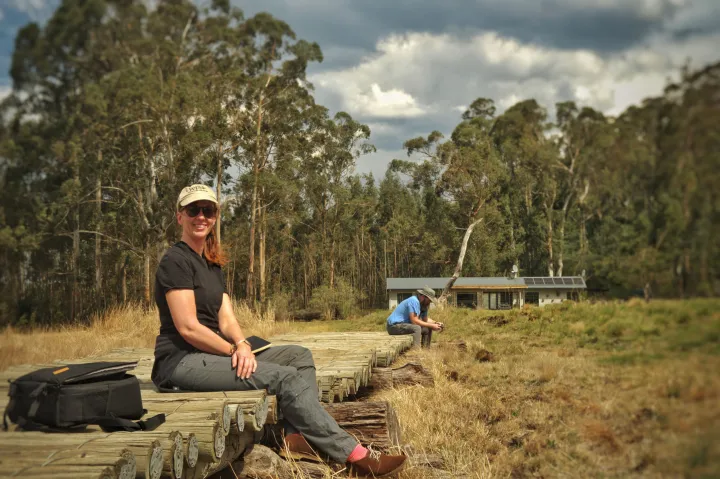Researchers showcase innovative projects using sound, art and even the tracks of small mammals to reveal what nature is quietly telling us about our changing planet and its history.
From frog calls and footprints, to pangolins cast in art, African researchers are finding unexpected ways to listen to nature. Their work, showcased at the 14th Oppenheimer Research Conference in Midrand this month, reflected the event’s spirit of “Preserving Our Precious Planet”.
More than 80 science poster displays offered a vivid snapshot of African research spanning ecology, food security, public health and art. Among them, six stand out for uncovering nature’s hidden signals and connecting science to the deeper stories of life.
Learning to listen
In the misty highlands of KwaZulu-Natal, an elusive amphibian is helping scientists tune into the health of South Africa’s threatened wetlands.
The long-toed tree frog, found only in the Midlands and southern Drakensberg, is the focus of a new conservation project that blends traditional fieldwork with cutting-edge technology – including call recordings, drone mapping, weather data and wetland monitoring – to better understand and protect this endangered species.
Amphibian scientist Jeanne Tarrant on site in the southern Drakensberg. (Photo: Kyle Smith)
The project, led by Jeanne Tarrant and a team of researchers with deep roots in the region, centres on a deceptively simple idea: learning to listen. By recording and analysing the chorus of calling males during breeding season, scientists can gauge the size and health of local frog populations and, by extension, the condition of the wetlands they depend on.
These high-elevation grasslands are under growing pressure from agriculture and exotic plantations, making effective habitat management essential for the frog’s survival and also for the sustainability of surrounding land use and water systems.
Beyond its scientific goals, the project also engages directly with local landowners to assess their attitudes towards conservation over time, and their willingness to enter into formal habitat protection agreements. This social component helps researchers to understand what drives cooperation – and where conservation interventions are most likely to succeed.
The research has already begun to shape on-the-ground conservation actions such as wetland rehabilitation and alien plant removal. It builds on recent Red List assessments of South Africa’s amphibians, using new data to test which management approaches are most effective in reversing population declines.
For Tarrant, the project is also deeply personal. “The long-toed tree frog was first described in Underberg, my hometown,” she explains. “It’s the species on our logo – a reminder that while our work starts locally, it connects to the bigger picture of amphibian conservation across Africa.”
The kitchen innovator
In a groundbreaking research approach to tackling malnutrition, food scientists Nkanyezi Radebe, Zabentungwa Hlogwane, Caswell Munyai and Muthulisi Siwela are exploring how a humble loaf of bread could help combat nutrient deficiencies across Africa.
Their poster presents compelling evidence that adding insect meal to bread can significantly boost its protein and mineral content – without changing its familiar taste or texture.
For millions of people in sub-Saharan Africa, bread is a daily staple. Yet, in its unfortified form, it lacks key nutrients such as protein, iron and zinc – deficiencies that contribute to widespread malnutrition, especially among low-income communities.
At the same time, edible insects are abundant, affordable and packed with nutrients, but often avoided due to cultural stigma or aversion to eating whole insects. Radebe’s research tackles both problems by using finely milled insect meal to enrich bread, making the nutrient boost invisible.
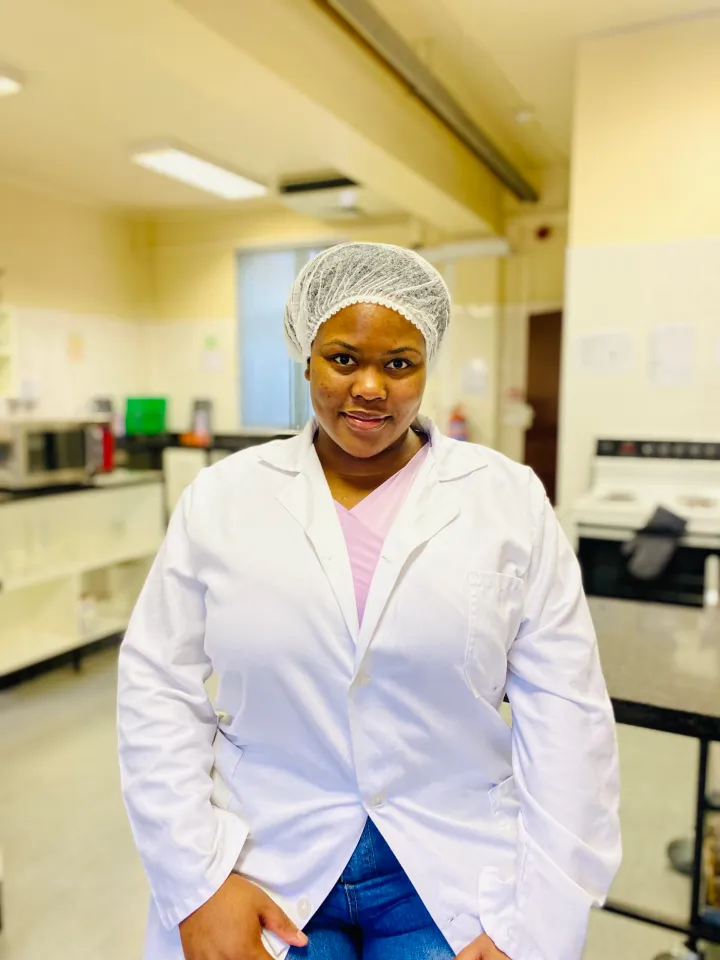
Nkanyezi Radebe leads the laboratory experiments on fortifying bread with milled insects. (Photo: Supplied)
The study tested different types and concentrations of insect meal in both white and brown bread. The results were striking: higher insect concentrations consistently improved protein, iron and zinc levels in all samples. This means that simply incorporating insect meal into a common food could provide a sustainable, culturally acceptable strategy for reducing nutrient deficiencies.
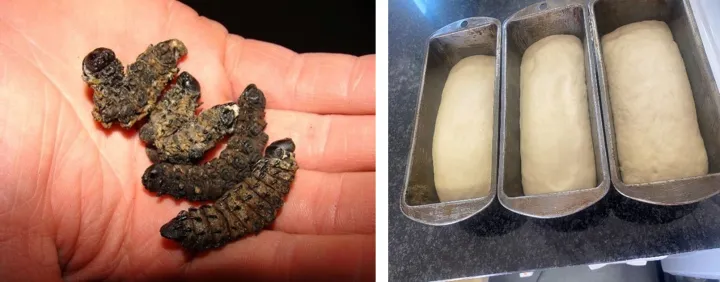
Mopani worms and dough prepared for baking. (Photo: Supplied)
Beyond improving diets, the approach carries significant environmental benefits. Insects require far less land, water and feed than traditional livestock.
Radebe’s motivation is deeply personal. “Growing up in a rural community, I saw how poverty led to nutrient-deficient diets,” she says. “Insects used to be part of traditional diets, but we lost that knowledge over time. This project is about finding a practical, sustainable way to bring that back, improving nutrition without forcing people to change what they eat.”
The artist’s lens
Imagine a pangolin on display – not alive, not preserved, but a human-made replica, standing in for a species that may soon survive only in memory or museums. This is the world that artist and curator Fritha Langerman explores in her poster presentation.
“At the heart of my work is the pangolin,” Langerman explains. “This project explores species loss through the lens of art and visual culture, using absence, fragmentation and replication to communicate extinction.”
Her internationally travelled exhibition, Freighted, first focused on rhinos and now turns to pangolins, tracing centuries of animal collection and display.
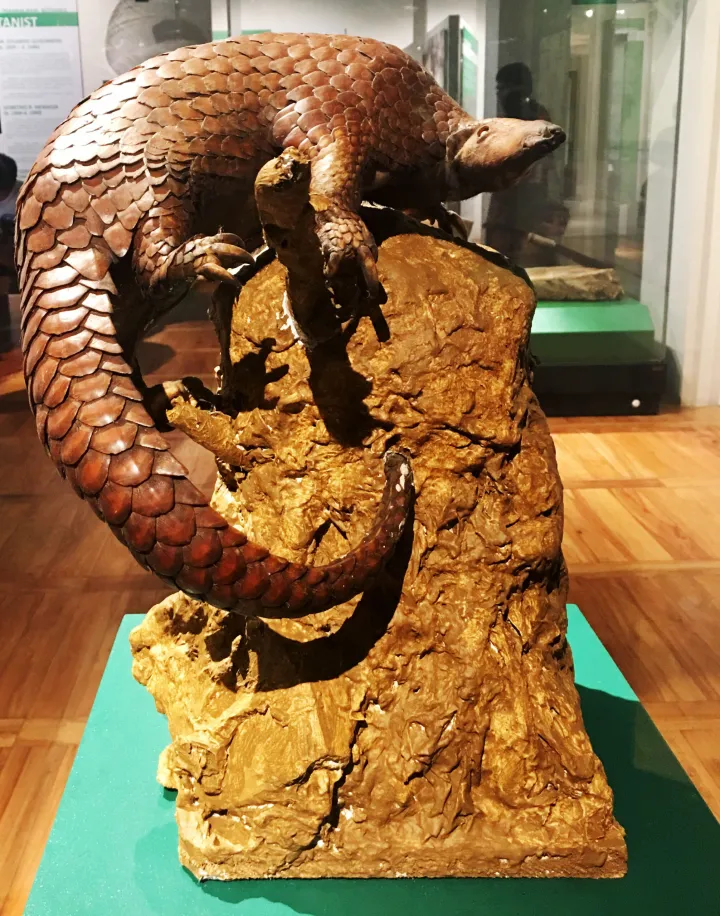
A taxidermied pangolin displayed at the Philippine National Museum. (Photo: Julan Shirwood Nueva / Wikimedia Commons)
From 16th-century trade routes to 19th-century natural history expeditions, countless African animals were removed and sent to European museums and zoos. Langerman reconstructs this history with carefully crafted models, fragments and installations.
“By constructing these exhibitions as simulations containing no original images or artefacts, attention is directed towards a future in which these endangered species may persist only as reproductions and absences,” she says.
The making of humans
What made humans the most feared predator in Africa? According to ecologist Norman Owen-Smith, it wasn’t just chance – it was the land itself.
In his poster, Owen-Smith shows that Africa’s geology, climate and abundant wildlife created the perfect “training ground” for our ancestors.
“The distinctive features of Africa’s ecology are ultimately derived from basement geology and continental movements,” he explains. “They govern seasonal dryness, local soil fertility and the prevalence of grassy savannas.”
These high-lying interiors with wet and dry seasons shaped sprawling savannas rich in grazing animals. For early humans, these landscapes offered a reliable source of energy: meat and bone marrow from herbivores that could digest tough, dry grasses.
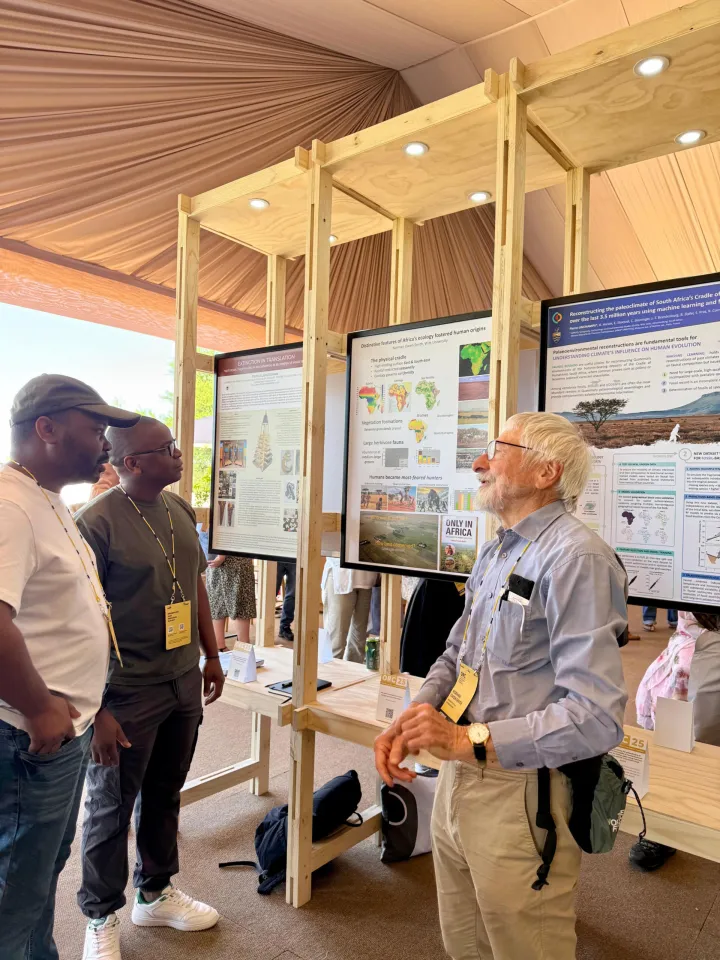
Ecologist Norman Owen-Smith showed how Africa’s geology, climate and abundant wildlife were vital in forming the crucible of human origins. (Photos: Supplied)
This combination of open terrain and abundant prey pushed humans through key evolutionary transitions. Our ancestors went from fruit-eating forest dwellers to savanna-hunting meat-eaters, developing intelligence, cooperation and tools along the way.
Owen-Smith connects this deep evolutionary past to modern conservation challenges. Africa’s large mammals are a global heritage that draw tourists from around the world, but they need space to cope with seasonal variation in order to survive.
Effective conservation depends on local communities benefiting from these protected areas, giving people a stake in preserving the landscapes that shaped both wildlife and humanity.
Ecological detectives
In a world where biodiversity is rapidly declining, scientists are turning to one of nature’s simplest traces – footprints – to uncover vital clues about ecosystem health.
The project “Paws for Thought: Using Footprint Identification Technology (FIT) to Assess Ecological Integrity Through the Lens of Small Mammals” showcases a powerful new way to monitor wildlife without ever capturing or disturbing it.
Led by Dr Zoe Jewell and Dr Sky Alibhai, with expert small mammalogists Dr Nico Avenant and Dr Maria Oosthuizen, the team demonstrates how cutting-edge technology, combined with traditional tracking knowledge, can reveal remarkable insights about even the smallest species.
Each footprint holds a wealth of information such as species, individual identity, sex and even age. What makes FIT especially exciting is that it’s non-invasive, low-cost and accessible.
At its core, the research addresses a global problem: ecosystems are deteriorating, but conventional monitoring methods are often too expensive, technical or disruptive to deploy widely. By providing an early-warning tool that communities themselves can use, FIT offers a way to detect subtle shifts in biodiversity and ecological function before damage becomes irreversible.
For Jewell, the inspiration was both scientific and personal. “We wanted to do conservation from the ground up in the literal and metaphorical sense,” she explains. “Small mammals are vital to ecosystem balance, yet so easily overlooked. Figuring out how to read their stories from something as delicate as a footprint was thrilling – and it opened up an entirely new way to listen to nature.”
The unlikely sentinel
Beneath the soil of South Africa’s Highveld, mole rats dig their tunnels, oblivious to the world above, yet these subterranean creatures may hold critical clues about environmental pollution.
Erin Brooke’s poster uses these animals as biological indicators, showing how pollutants like microplastics and phthalates move from the environment into wildlife.
“My poster demonstrates how environmental pollutants, namely microplastics and phthalates, are being transferred to even the most unsuspecting of wildlife,” Brooke explains.
“By quantifying the levels of exposure to these contaminants that these animals are facing, my research aims to lay the foundation to fill this knowledge gap using the Highveld mole rat as a model animal.”
Microplastics and the chemicals that plastics release are now found everywhere on the planet, but terrestrial wildlife, especially species that live underground, have largely been overlooked. Brooke’s research addresses this gap, showing that subterranean animals are regularly exposed to contaminants.
“This exposure and the subsequent accumulation of these contaminants in the body of these animals has major implications for the potentially devastating physiological effects these contaminants may pose on Highveld mole rats as well as other wildlife.”
The implications extend far beyond the mole-rats themselves. If soil-dwelling organisms are affected by pollution, soil fertility and crop quality could also be compromised, with consequences for food security.
Brooke adds that her findings could help guide waste management policies, providing evidence to support stricter regulations on plastic disposal and other pollutants.
Her motivation is deeply personal: “I was inspired after seeing the increase in media reporting on the occurrence and effects of microplastic exposure on human health,” she says.
“I discovered that very little research was being done on animal exposure and health, let alone in terrestrial animals. This severe knowledge gap then inspired me to take on this project.”
Brooke’s poster turns the Highveld mole rat into an environmental sentinel, using a small, hidden species to reveal the larger, pervasive threats of pollution – and offering insights that could protect both ecosystems and human health. DM
This story first appeared in our weekly Daily Maverick 168 newspaper, which is available countrywide for R35.

![]()
Images are for reference only.Images and contents gathered automatic from google or 3rd party sources.All rights on the images and contents are with their legal original owners.
